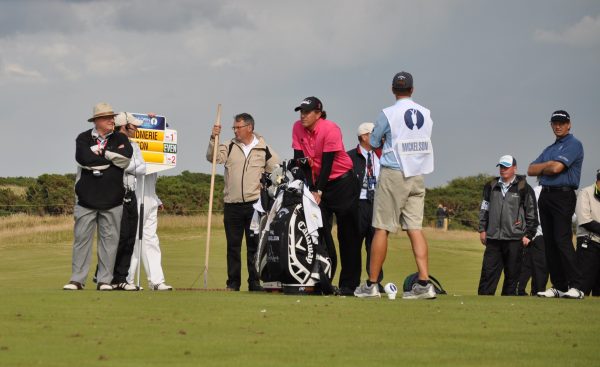
Slow play has become a major issue in the golfing industry, and it represents a significant threat to the long-term health of the game. With five-hour rounds becoming the norm, golfers are abandoning the game in droves, and new players are hesitant to start out.
This month, we present a complete “Inside and Out” strategy to tackle slow play, both from a course management (“inside”) perspective, and a player/member (“outside”) perspective.
“INSIDE” – TIPS FOR THE CLUB/COURSE
By Mike Orloff
We continue to read and hear the endless stories of players complaining about “slow play” at our facilities. “We did not see a Marshall” is a common complaint, along with “we called the pro shop to tell them about the slow group ahead of us, but they never came out to help”, or “the group ahead of us were beginners and were really slow,” etc.
So who is to blame, the golfer or the facility?
In most cases, this is a management issue more than a player issue. At the end of the day it is up to management to ensure that everyone has a respectable pace during their golf round.
The strategy lies in three key areas: education of golfers and staff, management of golfers, and general course set-up.
The two concepts that you must also fully understand to properly manage this issue are Pace and Flow.
Pace basically is the measurement of time it takes you to play your round. I.e. “it took you four hours to play”. Pace issues are primarily caused due to lack of player education and improper course setup.
Flow has to do with the consistency of the time it took to play. I.e. it took you four hours to play, but with delays due to a group ahead of you. Flow issues are primarily caused by improper course setup and overall lack of management of the process.
It’s critical to proactively manage a large number of players, most importantly starting with the first groups out each morning. Envisage the 18-hole round like two spinning wheels, with each nine being a separate wheel. Try to get the early groups to get the front wheel spinning at a great pace, which ultimately will get the second wheel spinning at a greater pace. One group can slow the pace of either wheel, so the quicker you identify this group, the better you will keep the wheels spinning.
Here are some strategies:
Manage the course
- Par 5’s -Extend the length as long as possible, so people are not waiting for the green to clear to try and reach in two shots.
- Par 4’s – Set to 330-350 metres maximum, so most players can reach or get close in two shots.
- Par 3’s – Keep at a maximum length of 150-160 metres, so the majority of players can reach the green in one hit.
- Green speed – keep at 9-10 on the Stimpmeter, so players are not regularly 3 and 4 putting or generally spending too much time on the green.
- Rough – lower height, so the majority of players can fully advance the ball if hitting from the rough.
- Pin positions – put in the easiest green position on busy days.
- Competitions – Set up the course to accommodate the format of the day. i.e. Don’t have the course play the longest and toughest if you’re conducting a stroke play club championship.
Manage the process
- Use a first tee starter on busy days to regulate the time between each group teeing off. Space the groups accordingly. If groups go off too quickly you risk them bottlenecking on a future hole, especially if you have a Par-3 early in the round.
- Use a more “experienced” staff member for marshalling duties. Ideally find someone who is very friendly and helpful to players, but who can also be assertive when necessary.
- Have policy and procedures (approved by member committee if at private club) on how to identify and handle issues, and in extreme cases, how to kick someone off the course, or penalise their competition score.
- Educate your staff. Most facilities do not have proper training of marshalling staff, or have really thought of the best person to put in the position of course Marshall.
- Communicate constantly with golf staff throughout the day to help identify trouble spots quickly and to make sure groups are properly paired.
Manage the expectation
- Educate players – Set the time expectation for players before they tee off and inform players of any unusual course conditions. If you are tracking a 5-hour round for that particular day, let them know before they start. If their expectation is changed before they tee off, you could circumvent any potential blow-ups.
- Player perception – many players don’t know exactly what time they teed off. In many cases they went off later than the tee time booked, which may result in them thinking it took longer than it actually did. Write the start time on a card and give it to each group.
To better understand where your issues really exist, start out by tracking every group that tees off over the next four Saturdays. Start with your first group off and have someone write down what time the group actually started (not when they checked in or what their tee time was supposed to be), then again when they finish nine holes, and finally when they finish 18 holes. You will most likely see a couple of groups in the morning (many times the same players each week) that are creating the slow play for the rest of the day.
The next slowest group off the tee always sets the pace for all players behind them. If you get off to a slow start in the morning, you will spend the entire day trying to recover. If you are having a slow pace day, leave the first tee open for as long as you can and this will at least give the later groups some relief on overall time taken to play by freeing up any bottlenecks on course.
The entire process must be controlled through a series of pre-emptive management strategies, otherwise you risk letting the players self-manage the process which is a potential for disaster.
“OUTSIDE” – Quick tips FOR THE PLAYER
By Richard Fellner
Here are some of the more game-speeding rules of course etiquette for players:
- Watch ALL balls until they stop
Searching for lost balls is one of the most time-consuming aspects of the game. After every shot keep an eye on the ball (yours and your playing partners’) until it comes to rest—even if it is in the fairway. If it has wandered into the deep rough or trees/bushes, identify a marker or reference – a specific tree, bush, distant house…anything. As you leave the tee, keep a line of sight onto that marker. - Hit a provisional
If there is even the slightest chance that a wayward ball could go walkabout, play a provisional — resist the rarely-accurate urge to say “Nah, we’ll probably find it.” - If it’s lost, it’s lost
When your five minutes is up, it’s up. The ball is lost. Move on. (You DID play a provisional on the tee, right?) - Do your pre-shot stuff BEFORE it’s your turn
Get prepared for your shot while riding or walking to your ball. Get the distance, check the wind, do a pre-shot routine ahead of time (while others are playing their shot) so that you’re ready to go IMMEDIATELY after your playing partner’s ball has finished moving. (Don’t use the PGA TOUR professionals as a guide here, as they are often the worst offenders.) - Play “Ready Golf”
Unless you are playing in a major competition or in a matchplay scenario, play “ready golf” at every opportunity. If a player in your group isn’t ready to hit, then (with their permission) play your shot. If a player in your group cannot hit the ball far, and isn’t in danger of hitting into the group ahead, then let them hit first while the “longer” hitters wait for the fairway to clear. When on or around the green, if a player is delayed (i.e. raking a bunker, etc) and you are ready to putt, then (with permission) have a go. - Go directly to your ball
Move quickly to your own ball. Avoid travelling in a group from one ball to the other. When sharing a cart, drop off one player and then proceed to your own ball while he/she does their pre-shot routine. - Take Multiple Clubs
If you need to leave your bag/buggy/ cart away from where your ball is positioned, take a couple of clubs with you. This will save you from having to go back and forth. If you are hitting from a greenside bunker, for example, then take both your wedge AND your putter. - Know the distance
A recent study has shown that GPS units and Laser rangefinders speed up play. If possible, invest in one of these devices. Alternately, get a course yardage book, or look out for sprinkler heads/yard-markers as you approach the ball (not after you get there.) - Keep the conversations in the carts
Save the jokes/stories until after everyone has hit off, and you are walking/driving to the next shot. Too often, we see people engaged in conversation with a wide open green or fairway ahead. - Always think ahead
As you approach the green, determine where the next tee is, and then park your cart/buggy/bag between the hole and the next tee. That way, when you are done with the hole, you can clear the green quickly. If you’ve brought multiple clubs to the green, then place them on the green in an exit area leading towards your buggy/bag. This way, after putting out, you will be able to quickly collect them on your way to the cart. Also, the first player to putt out should aim to help collect all extra clubs while the other players putt out. - Read the green while others are putting
As you approach the green, check the contours, high/low points and overall slope of the entire green. While others are putting, you can then take the opportunity to read your particular break and determine your pace, etc. Watch others’ putts to get further information about speed and break. Once your partner has putted out, you should be immediately ready to hit your own ball. - Clear the green quickly
Don’t loiter around the green discussing the scores. Clear the green for the group behind and then record your scores at the next tee or en route. If your foursome have fallen behind, the first two players to putt out should immediately head over to the next Tee and hit off.
- Pick up
If playing Par, Stableford or other non-stroke formats, if you are out of the hole (Wipe, minus, etc), and you are falling behind the group ahead, then pick up your ball and move on. - Look around
Remember: “Keep behind the group in front, not in front of the group behind”. If the group in front of you is more than one shot ahead (i.e. if they are on the green of a par-4 before you even tee off) you need to speed it up. Conversely, if there is no one ahead of you, but the group behind is constantly waiting for you to hit, either pick up the pace or let them hit up/play through.




![Win the golfing experience of a lifetime, at the Hawai‘i International Week of Golf, valued at $6,900 [Winner Announced] Win the golfing experience of a lifetime, at the Hawai‘i International Week of Golf, valued at $6,900 [Winner Announced]](https://www.insidegolf.com.au/wp-content/uploads/Hawaii-Comp-500x294.jpg)